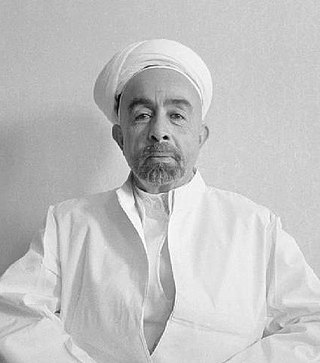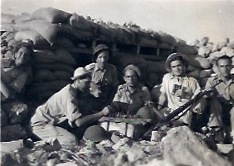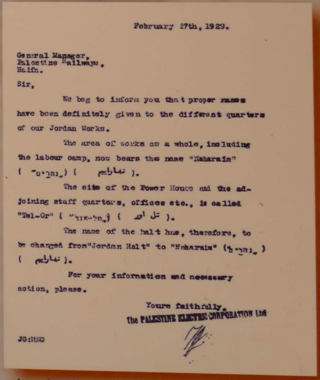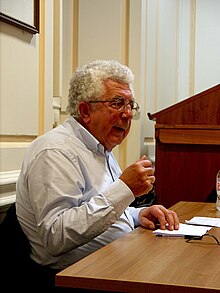
Zionist political violence refers to acts of violence or terrorism committed by Zionists in support of establishing and maintaining a Jewish state in Palestine. These actions have been carried out by individuals, paramilitary groups, and the Israeli government, from the early 20th century to the present day, as part of the ongoing Israeli-Palestinian conflict.

The 1948 Arab–Israeli War, also known as the First Arab–Israeli War, followed the civil war in Mandatory Palestine as the second and final stage of the 1948 Palestine war. The civil war became a war of separate states with the Israeli Declaration of Independence on 14 May 1948, the end of the British Mandate for Palestine at midnight, and the entry of a military coalition of Arab states into the territory of Mandatory Palestine the following morning. The war formally ended with the 1949 Armistice Agreements which established the Green Line.
Palestinian refugees are citizens of Mandatory Palestine, and their descendants, who fled or were expelled from their country over the course of the 1947–1949 Palestine war and the Six-Day War. Most Palestinian refugees live in or near 68 Palestinian refugee camps across Jordan, Lebanon, Syria, the West Bank and the Gaza Strip. In 2019 more than 5.6 million Palestinian refugees were registered with the United Nations.

Abdullah I bin Al-Hussein was the ruler of Jordan from 11 April 1921 until his assassination in 1951. He was the Emir of Transjordan, a British protectorate, until 25 May 1946, after which he was king of an independent Jordan. As a member of the Hashemite dynasty, the royal family of Jordan since 1921, Abdullah was a 38th-generation direct descendant of Muhammad.

Killings and massacres during the 1948 Palestine war resulted in the deaths of hundreds of civilians and unarmed soldiers.

Benny Morris is an Israeli historian. He was a professor of history in the Middle East Studies department of Ben-Gurion University of the Negev in the city of Beersheba, Israel. Morris was initially associated with the group of Israeli historians known as the "New Historians", a term he coined to describe himself and historians Avi Shlaim, Ilan Pappé and Simha Flapan. Scholars have perceived an ideological shift in Morris's work and a departure from the critical scholarship of his New Historian colleagues starting around 2000 during the Second Intifada.
Plan Dalet was a Zionist military plan executed in the civil war phase of the 1948 Palestine war for the conquest of territory in Mandatory Palestine in preparation for the establishment of a Jewish state. The plan was requested by the Jewish Agency leader and later first prime minister of Israel David Ben-Gurion, and developed by the Haganah and finalized on March 10, 1948. Historians describe Plan Dalet, in which Zionist forces shifted to an offensive strategy, as the beginning of a new phase in the 1948 Palestine war.
The 1947–1948 civil war in Mandatory Palestine was the first phase of the 1947–1949 Palestine war. It broke out after the General Assembly of the United Nations adopted a resolution on 29 November 1947 recommending the adoption of the Partition Plan for Palestine.

Yoav Gelber is a professor of history at the University of Haifa, and was formerly a visiting professor at the University of Texas at Austin.
During the 1948 Palestine war in which the State of Israel was established, around 700,000 Palestinian Arabs or 85% of the total population of the territory Israel captured fled or were expelled from their homes by Israeli forces. The causes for this mass displacement is a matter of great controversy among historians, journalists, and commentators.

The 1949–1956 Palestinian expulsions were a continuation of the 1948 expulsion and flight of Palestinian Arabs from Israeli-controlled territory that occurred after the signing of the ceasefire agreements. This period of the exodus was characterised predominantly by forced expulsion during the consolidation of the state of Israel and ever increasing tension along the ceasefire lines ultimately leading to the 1956 Suez Crisis.

Muhammad Nimr al-Hawari was a Nazareth-born Palestinian who studied law in Jerusalem, graduating in 1939. Al-Hawari served in the British Mandate administration as chief interpreter in the district court of Jaffa and chairman of the Association of Government second-division officers. He was transferred to Haifa where he resigned his government position in 1942. On his resignation, he returned to practicing law in Jaffa. Al-Hawari started his career as a devoted follower of Amin al-Husseini but broke with the influential Husseini family in the early 1940s. Muhammad Nimr Al-Hawari, during the termination of the British mandate, formed and commanded al-Najjada, a paramilitary armed movement. Al-Hawari was in command of the militia in the defence of Jaffa until he fled in the mass exodus of Palestinians in late December 1947. Al-Hawari fled from Jaffa to Ramallah in December 1947. Al-Hawari together with ‘Aziz Shihada a lawyer from Ramallah opened an office in the West Bank for refugee affairs. Hawari returned to Palestine and years later became judge in the District Court of Nazareth.

Ezra Danin was the head of the Arab section of the SHAI, the intelligence arm of the Haganah, Israeli politician and an orange grower. Danin specialized in Arab affairs.

The 1948 Palestinian expulsion from Lydda and Ramle, was the expulsion of 50,000 to 70,000 Palestinian Arabs when Israeli troops captured the towns in July that year. The military action occurred within the context of the 1948 Arab–Israeli War. The operation included the events of the Lydda Massacre and the Lydda Death March. The two Arab towns, lying outside the area designated for a Jewish state in the UN Partition Plan of 1947, and inside the area set aside for an Arab state in Palestine, were subsequently transformed into predominantly Jewish areas in the new State of Israel, known as Lod and Ramla.

Naharayim, historically the Jisr Majami area, is the area where the Yarmouk River flows into the Jordan River. It was the site of the "First Jordan Hydro-Electric Power House", constructed between 1927–33, and located near an ancient Roman bridge known as Jisr Majami. The site was named by the Palestine Electric Company which assigned "proper names" to the "different quarters of our Jordan Works", one of these being the "works as a whole including the labour camp" to be called "Naharaim", and another being the site of the "Power House and the adjoining staff quarters, offices" to be called Tel Or. Most of the plant was situated in the Emirate of Transjordan and stretched from the northern canal near the Ashdot Ya'akov in Northern Mandatory Palestine to the Jisr el-Majami in the south.
In the 1948 Palestine war more than 700000 Palestinian Arabs – about half of Mandatory Palestine's Arab population – fled from their homes or were expelled, at first by Zionist paramilitaries, and after the establishment of the Israel, by its military. The expulsion and flight was a central component of the fracturing, dispossession, and displacement of Palestinian society, known as the Nakba. Dozens of massacres targeting Arabs were conducted by Israeli military forces and between 400 and 600 Palestinian villages were destroyed. Village wells were poisoned in a biological warfare programme and properties were looted to prevent Palestinian refugees from returning. Other sites were subject to Hebraization of Palestinian place names.

The Ethnic Cleansing of Palestine is a book authored by New Historian Ilan Pappé and published in 2006 by Oneworld Publications. The book is about the 1948 Palestinian expulsion and flight, which Pappe argues was the result of ethnic cleansing.

The Arab Liberation Army, also translated as Arab Salvation Army or Arab Rescue Army (ARA), was an army of volunteers from Arab countries led by Fawzi al-Qawuqji. It fought on the Arab side in the 1948 Palestine war and was set up by the Arab League as a counter to the Arab High Committee's Holy War Army, but in fact, the League and Arab governments prevented thousands from joining either force.
The New Historians are a loosely defined group of Israeli historians who have challenged traditional versions of Israeli history, including Israel's role in the 1948 Palestinian expulsion and flight and Arab willingness to discuss peace. The term was coined in 1988 by Benny Morris, one of the leading New Historians. According to Ethan Bronner of The New York Times, the New Historians have sought to advance the peace process in the region.

The 1948 Palestine war was fought in the territory of what had been, at the start of the war, British-ruled Mandatory Palestine. During the war, the British withdrew from Palestine, Zionist forces conquered territory and established the State of Israel, and over 700,000 Palestinians fled or were expelled. It was the first war of the Israeli–Palestinian conflict and the broader Arab–Israeli conflict.














